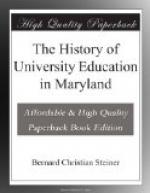The Faculty of Theology reported in 1852 “no active organization of the faculty has ever been attempted and, in view of the character of the department contemplated by the charter, none seems desirable.” Its only activity was a course or two of lectures on the Evidences of Christianity, delivered before the medical students about 1823 by the Rev. William E. Wyatt, Professor of Theology. A nominal organization of the faculty was kept up, however, until 1878.
The prosperity of the medical department was destroyed by the effort of some of its professors, discontented with being prohibited from having private classes, to have the Legislature do away with the regents and replace them with a board of trustees, in whom should vest the property. As early as November 12, 1824, the Regents feared trouble and obtained from William Wirt, John Purviance and Daniel Webster, a legal opinion that their position was inexpugnable. With this conclusion the Legislature did not agree, and on March 6, 1862, an act was passed abolishing the Regents and appointing a Board of twenty-one Trustees in their place.[19]
The Trustees, by decree of the courts, obtained control of the property and forced the professors to accept them as the legal authority. So matters went on for twelve years, until in 1837, the trustees appointed a professor personally objectionable to some of the others, who resigned their positions under the Trustees and opened a separate medical school in the Indian Queen Hotel at the corner of Baltimore and Hanover Streets. Few out-of-town students attended either school, for the quarrel frightened them away, and the Baltimore students largely attended the Regents’ school. Feeling ran high at one time, the Regents took possession of the University buildings by force, and bloodshed was feared.




